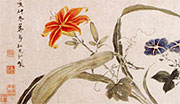Daylilies
Modern daylily hybrids have bright, cheerful flowers which come in a wide range of colours, including yellows, buffs, oranges, reds and other shades towards plum-purple and deep reddish violet. They are called daylilies because individual flowers come out in the morning and are usually gone by the end of the day. These beautiful hybrids are all derived from daylily species that are native to eastern China. In our segment Peter Valder looked at a very old-fashioned variety of daylily which has been cultivated and used in China since ancient times.
Orange or tawny daylily (Hemerocallis fulva)
Thousand-year-old Chinese paintings show daylilies with flowers very similar to those of the orange or tawny daylily. Flowers of this type also feature as decorative motifs on porcelain.
In China daylilies have long been used as herbs. You just put the daylily under your pillow, or use a pillowslip embroidered with a daylily, and you will forget your sorrows. The Chinese also believed that women who wore daylilies in their girdles would conceive sons.
The brownish yellow flower buds of the orange daylily are dried and used as a food and a medicine. They are sold in large quantities in Chinese food markets, where they are known as flower vegetable or yellow flower vegetable. When cooked they have a sweetish taste and a moist, soft, gelatinous texture. Peter once tried them in a Shanghai restaurant and found their flavour pleasant, but unexciting. However, he was interested to note that they pass through the system almost intact!
Growing daylilies:
In hot tropical climates evergreen varieties are best, while deciduous varieties do better in cold climates. Both evergreen and deciduous varieties will grow well in temperate climates.
Daylilies can be planted throughout the year, but in cold climates autumn and spring plantings are best.Daylilies require a minimum of six hours of sunshine every day to flower well. They will grow in dry, well-drained or boggy soils and are tolerant of drought, snow, frost, winds and salt. They are relatively free of pests and diseases.
Getting started:
Daylilies cost about $10-$20 each, up to $80 for rare varieties. Miniatures start at around $5. They are available in pots from nurseries, or from daylily specialists such as:
NSW
Rainbow Ridge Nursery
8 Taylors Road, Dural, 2158
Phone: (02) 9651 2857
Plants are sold at the nursery from 10am-4pm until December 24, or by mail order throughout Australia. Catalogues cost $5.
QLD
Mountain View Daylily Nursery
PO Box 458, Maleny, 4552
Phone: (07) 5494 2346 Fax: (07) 5499 9774
Send for free 10 page catalogue
Email: [email protected]
Website: www.daylily.com.au
VIC
Tempo Two Nursery
57 East Road, Pearcedale, 3912
Phone: (03) 5978 6980 Fax: (03) 5978 6235
Open every day 10am-5pm from 15 October to the end of November. Other times Mon-Fri, 8am-4pm. Catalogue $5 (but refundable if purchases made).
Further reading:
‘The Garden Plants of China’, by Peter Valder (1999). Published by Florilegium (ISBN 1876314028). rrp $88.
‘Daylilies for the Garden’, by Graeme Grosvenor (Kangaroo Press). You can buy it at bookstores or have it mailed (postage free) from Rainbow Ridge Nursery. Cost: $59.95.



